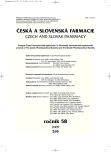Hypolipidemic effect of amaranth constituents
Authors:
Z. Chmelík; V. Závalová; P. Suchý; H. Kotolová; P. Kollár
Authors‘ workplace:
Veterinární a farmaceutická univerzita Brno, Farmaceutická fakulta, Ústav humánní farmakologie a toxikologie
Published in:
Čes. slov. Farm., 2009; 58, 200-202
Category:
Original Articles
Overview
More than 60 plant species of the genus Amaranthus spreading from the tropical to moderate zone have been classified. For a number of years, the amaranth (Amaranthus sp.) has been considered to be a crop-plant with a high nutritional index. Thanks to this property it has become an important component of food not only for people but also a suitable component of fodder mixtures for farm animals. Potential biological effects of the amaranth which could be employed therapeutically in the prevention or therapy of metabolic disorders have been studied in a number of preclinical studies. The papers have focused on the nutritional value of amaranth products, in particular on the hypolipidemic effect. Both of these useful properties are considered, together with relatively small demands for cultivation, to be one of the greatest positive properties offered by the use of the amaranth. Though the amaranth has a very good potency for a possible non-pharmacological action in the therapy or prophylaxis of dyslipidemias, further experiments are needed for a more detailed analysis of the mechanism of effect of its constituents. The present paper aims to summarize the knowledge concerning the hypolipidemic properties of the amaranth and its constituents.
Key words amaranth – squalene – hypolipidemic agent – nutrition
Sources
1. Kalač, P., Moudrý J.: Czech J. Food Sci., 2000; 18, 201–206.
2. Jarošová, J.: Úroda, 1997; 7, 19–23.
3. Bresani, R., Sánchez-Maroquín, A., Morales, E.: Food Rev. Int., 1992; 8, 23–49.
4. Segura-Nieto, M., Vazquez-Sanchez, N., Rubiovalasquez, H. et al.: J. Agr. Food Chem., 1992; 40, 1553–1558.
5. Budin, J. T., Breene, W. M., Tutnam, D. H.: J. Am. Oil Chem. Soc., 1996; 73, 475–481.
6. Do, R., Kiss, R. S., Gaudet, D. et al.: Clin. Genet., 2009; 75, 19–29.
7. Sun, H., Weiseborn, D., Rayas-Duarte, P. et al.: J. Am. Oil Chem. Soc., 1995; 74, 413–418.
8. Smith T. J.: Exp. Opin. Invest. Drugs, 2000; 9, 1841–1848.
9. Rao, C. V., Newmark, H. L.: Cancerogenesis, 1998; 19, 287–290.
10. Khor, H. T., Chieng, D. T.: Asia Pac. J. Clin. Nutr., 1997; 6, 36–40.
11. Meittinen, T. A., Vanhane, H.: Am. J. Clin. Nutr., 1994; 59, 356–363.
12. Huang, Z. R., Lin, Y. K., Fang, J. Y.: Molecules., 2009; 14, 540–554.
13. Jahaniaval, F., Kakuda, Y., Marcone, M. F.: J. Am. Oil Chem. Soc., 2000; 77, 847–852.
14. Maier, S. M., Turner, N. D., Lupton, J. R.: Cereal Chemistry, 2000; 77, 297–302.
15. Berger, A., Monnard, I., Bilat, M.: Proc. Germ. Nutr. Soc., 2000; 2, 28.
16. Quershi, A. A., Lehmann, J. W., Peterson, D. M.: J. Nutr., 1996; 126, 1972–1978.
17. Grajeta, H.: Bromatologia i Chemia Toksykologiczna, 1997; 30, 25–30.
18. Berger, A., Gremaud, G., Baumgartner, M. et al.: Int. J. Vitam. Nutr. Res., 2003; 73, 39–47.
19. Chaturvedi, A., Srojini, G., Devi, N. L.: Plant Foods Human Nutrition, 1993; 44, 63–70.
20. Shinn, D. H., Heo, H. J., Lee, Y. J. et al.: Br. J. Biomed. Sci., 2004; 61, 11–14.
21. Punita, A., Chatuverdi, A.: Plant Food Hum. Nutr., 2000; 55, 147–157.
Labels
Pharmacy Clinical pharmacologyArticle was published in
Czech and Slovak Pharmacy

2009 Issue 5-6
Most read in this issue
- Methods of preparation of microparticles in pharmaceutical technology
- Contributions to the development of advertising in pharmacy I
- Examination of selected quality parameters of the parenteral nutrition AIO – a pilot study
- Hypolipidemic effect of amaranth constituents
